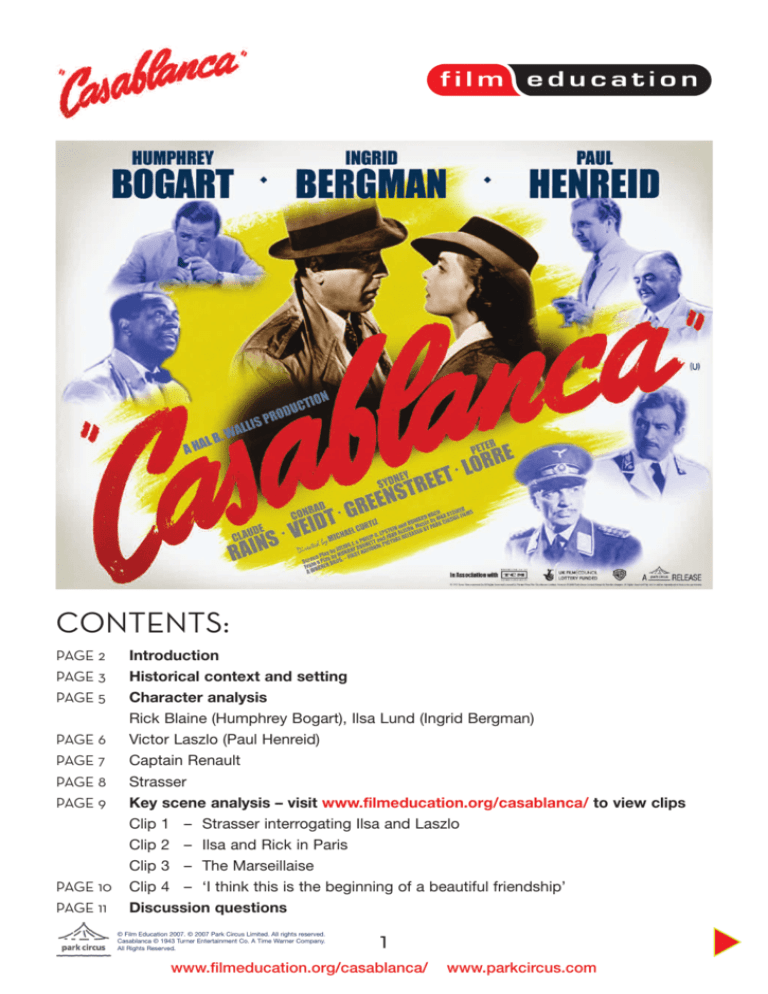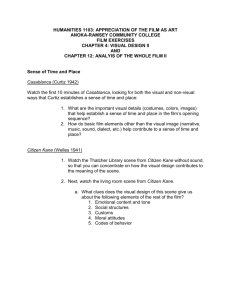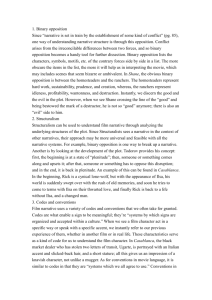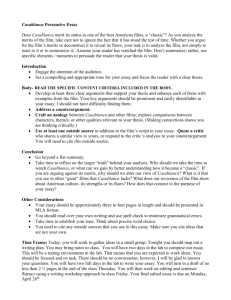
CONTENTS:
PAGE 2
PAGE 3
PAGE 5
PAGE 6
PAGE 7
PAGE 8
PAGE 9
PAGE 10
PAGE 11
Introduction
Historical context and setting
Character analysis
Rick Blaine (Humphrey Bogart), Ilsa Lund (Ingrid Bergman)
Victor Laszlo (Paul Henreid)
Captain Renault
Strasser
Key scene analysis – visit www.filmeducation.org/casablanca/ to view clips
Clip 1 – Strasser interrogating Ilsa and Laszlo
Clip 2 – Ilsa and Rick in Paris
Clip 3 – The Marseillaise
Clip 4 – ‘I think this is the beginning of a beautiful friendship’
Discussion questions
© Film Education 2007. © 2007 Park Circus Limited. All rights reserved.
Casablanca © 1943 Turner Entertainment Co. A Time Warner Company.
All Rights Reserved.
1
www.filmeducation.org/casablanca/
www.parkcircus.com
INTRODUCTION
These study notes, linked to key sequences from the film, are aimed at AS/A2 Film Studies and
Media Studies. A Level students studying History or Politics may also find them useful.
Elements in the Highers Media Analysis include representation, purpose and narrative structure.
They aim to bring the classic film Casablanca to a new audience through contextualisation and
analysis.
© Film Education 2007. © 2007 Park Circus Limited. All rights reserved.
Casablanca © 1943 Turner Entertainment Co. A Time Warner Company.
All Rights Reserved.
2
www.filmeducation.org/casablanca/
www.parkcircus.com
HISTORICAL CONTEXT AND SETTING
You may well be able to quote (or misquote!) some of the dialogue from Casablanca even if you
have never seen it. ‘Play it, Sam’; ‘We’ll always have Paris’ and ‘I think this is the beginning of
a beautiful friendship’ have become part of the lexicon of film history and have been voted some
of the most memorable film quotations of all time.
Casablanca was first screened in New York on 26 November, 1942, coinciding with the Allied
invasion of North Africa and the capture of the city of Casablanca. It was more widely released
on 23 January, 1943, during the high-profile meeting between Churchill and Roosevelt in
Casablanca itself. The critical reception to the film was generally good, and it was nominated
for eight Academy® Awards and won three: the Academy® Awards for Best Picture, Directing
and Writing: Adapted Screenplay. The main theme song, ‘As Time Goes By’, also became a
great hit.
To understand the reason why this film is deemed a classic, new audiences need to consider
the historical context of the film in a way that the audience in 1943 didn’t need to.
If you have seen the film before, these notes are designed to highlight some areas that you may
not have considered before or may wish to use as a basis for discussion. However, the first
section here aims to provide some broad explanation of the political context, so that users from
all areas of interest can use these points as a way into the text.
The film is set in Casablanca, Morocco in the early days of the Second World War. Morocco was
a French Colony up until 1956. The main agents of action represented in the film are the Vichy
government, the Nazis and the Resistance.
l Vichy – this is the name of the regime
that took power in France between 1940
and 1944. A power sharing agreement was
reached between the Nazi and Vichy
parties, resulting in the partition of France.
The French government had to pay the
costs of the German troops in the country,
and allow the German army to arrest
whoever they wanted. This is famously
featured in Casablanca, when we see the
Nazi army march into Paris, forcing Sam
and Ilsa to leave. Many French saw the
arrangement
between
the
Vichy
government and the Nazis as a betrayal.
The Vichy government were loyal to and
respectful of the Nazis. This surrender
incensed
many
French
people,
encouraging them to join the Resistance.
© Film Education 2007. © 2007 Park Circus Limited. All rights reserved.
Casablanca © 1943 Turner Entertainment Co. A Time Warner Company.
All Rights Reserved.
3
www.filmeducation.org/casablanca/
www.parkcircus.com
l The Resistance – this is the name given to French nationals and others fighting against the
oppression and suffering caused by the Nazi and Vichy regimes. They took enormous personal
risks, working behind enemy lines and helping the Allies, through gathering information and
carrying out various other missions. In the film we meet Victor Laszlo, a Czech national, who we
come to learn is an important figure in the Resistance movement, making Ilsa’s role in
supporting Laszlo all the more vital.
l The Nazi Party – the Nazi party were a force in German politics between 1920 and 1945. Their
policies included the eradication of Jews, Gypsies, homosexuals and the mentally and
physically ill, as well as encouraging the domination of the Aryan ‘master race’. In Casablanca
we meet Strasser, who represents the Nazi presence in Casablanca; his actions are indicative
of the party ideology.
CASABLANCA – CONTEXT AND SETTING
During the Second World War, many people were displaced from their countries, either to fight
(such as American soldiers in England or German soldiers in Morocco), or fleeing persecution,
as Laszlo is.
In a geographical sense, the choice of Casablanca as a setting is essential to the way that the
narrative develops, as all the characters are, in a sense, visitors there. Casablanca’s connection
to France, but geographical distance, means that the representatives of Vichy France, the
Resistance, and the Nazi Party behave in ways that would not have been possible in, for
example, occupied France. Here these groups are forced to co-exist, resulting in moments of
tension and danger for our characters.
Rick’s character is able to maintain a key role in the middle of these complex relationships as
he appears, at this stage in the war, to be ‘neutral’, coming from a country which had not yet
joined the war on either side. However, his character undergoes a transformation during the
course of the film, as his initial position as self-interested club owner changes to reveal his
complicated relationship with Captain Renault, and allegiance to Ilsa and the wider Resistance
movement that she and Laszlo represent.
© Film Education 2007. © 2007 Park Circus Limited. All rights reserved.
Casablanca © 1943 Turner Entertainment Co. A Time Warner Company.
All Rights Reserved.
4
www.filmeducation.org/casablanca/
www.parkcircus.com
CHARACTER ANALYSIS
The main characters that we meet offer a range of contradictory positions. By considering them
individually we can see how they change and develop and how their characteristics can be
interpreted as standing for wider positions and representing the huge international tensions of
the time.
RICK BLAINE (HUMPHREY BOGART)
Blaine is initially presented to us as a man who is only out to
preserve himself and if this means providing the best table for
Strasser and his men, or ensuring that Renault is
accommodated then so be it. As the narrative progresses, his
character reveals a morality that would have been familiar to
film-goers at the time and to anyone who has seen The
Maltese Falcon (Huston, 1941). The attributes of Rick and
arguably of Bogart in a number of other films (for example To
Have and To Have Not (Hawks, 1944), and The African Queen
(Huston, 1951)) include an unconventional hero, someone
who is on the outside of authority groups such as the police.
In Casablanca reference is made to his profiteering from
trading arms during conflicts. However, on closer consideration his choices reveal a morality that
it seems he is trying to keep secret. In Casablanca we see Rick taking great personal risks and
working for a greater good. Considering the difference that celebrity makes to the possible role
played and direction of the narrative is also interesting. It is important to remember that Bogart
was a major star (as were other members of the cast). His star persona as suggested above was
an unconventional hero, and to see his name on the poster or in cinema trailers may have led
audiences to have certain expectations of his character. Can you think of contemporary stars that
seem to stand for particular attitudes or behaviours?
The character of Blaine has also been interpreted as standing for the US, as he too is reluctant to
get involved in the war and during this initial period is clearly seen to be serving his own interests.
ILSA LUND (INGRID BERGMAN)
Ilsa functions as an important link in the narrative. She
connects Laszlo and Blaine, providing them and us with an
opportunity to consider life under those conditions from a
very particular perspective. Ilsa meets Rick in Paris; her love
is thwarted by the circumstances in which she lives. The
narrative complications that make her important are
essentially based on her attempt to behave in a normal way,
and in this case this is through her pursuit of romantic
relationships. During Rick and Ilsa’s final scene, before the
Nazis march on Paris, they break their own rule and ask each
other about their pasts. It is then that we learn that she
© Film Education 2007. © 2007 Park Circus Limited. All rights reserved.
Casablanca © 1943 Turner Entertainment Co. A Time Warner Company.
All Rights Reserved.
5
www.filmeducation.org/casablanca/
www.parkcircus.com
believes Laszlo to be dead. From this perspective we can see why she gets involved with Rick,
and later on in the film her dilemma at discovering Laszlo is alive, only to be confronted with
Rick once the pair arrive in Casablanca. The combination of her romantic needs and her sense
of duty to her husband and all that Laszlo represents results in the final conclusion.
VICTOR LASZLO (PAUL HENREID)
Laszlo is certainly the hero of the piece. His stature as hero is established by reputation through
various sources. The Nazis are concerned about his arrival in Casablanca and his significance
is such that intelligence has been gathered tracking his movements where possible. We are
witness to several significant scenes demonstrating his power and influence, not least the
scene in the bar where the Marseillaise is played and sung in a display of pride and defiance (to
see this clip, go to www.filmeducation.org/casablanca). The use of the Hollywood star system
is very significant in terms of the central relationships that we see. The casting of Bogart and
Bergman means that despite the narrative conclusion, and the obvious scenes that indicate
Laszlo’s heroic status, it is Rick and Ilsa who are the main romantic couple, and their scenes are
the most identifiably romantic.
Left to right: Laszlo, Ilsa and Rick
© Film Education 2007. © 2007 Park Circus Limited. All rights reserved.
Casablanca © 1943 Turner Entertainment Co. A Time Warner Company.
All Rights Reserved.
6
www.filmeducation.org/casablanca/
www.parkcircus.com
CAPTAIN RENAULT
Renault is the representative of the Vichy government in Morocco. Throughout the film he is
seen to be ambiguous. For example, Renault describes Strasser as ‘one of the reasons the
Third Reich enjoys the reputation it has today’. His speech suggests that he is playing a
potentially dangerous game, whereby he is belittling the Nazis on one level, but making
‘innocent’ comments on the other. Even though he is identifiable as a form of authority, and his
actions are in keeping with the Vichy regime (he has Ugarte arrested and shot; he has the power
to close and search Rick’s bar and he informs Strasser of Rick’s collaboration with Laszlo), we
are aware that he is doing what he needs to do to survive. The use of stars is again interesting
here, as Claude Rains was a familiar face to audiences for his work including Mr Smith Goes To
Washington (Capra, 1939) and The Sea Hawk (Curtiz, 1940). It is therefore unlikely, therefore,
that audiences at the time would have identified him as a ‘bad guy’. In the final scenes, despite
all that has gone on before, Renault and Rick come to an understanding, and are seen to be
very much united. This suggests that Renault, despite his status as a Vichy representative, is
able to shrug this role off and do the right thing.
(See clip 4)
Renault is 2nd from the left
© Film Education 2007. © 2007 Park Circus Limited. All rights reserved.
Casablanca © 1943 Turner Entertainment Co. A Time Warner Company.
All Rights Reserved.
7
www.filmeducation.org/casablanca/
www.parkcircus.com
STRASSER
When we meet Strasser it is clear that he is in charge.
However, the specifics of Casablanca mean that his power is
not as absolute as it might be. Here he is required to at least
be seen to deal reasonably with Laszlo. Strasser’s arrival in
Casablanca signifies a development in the situation, and also
demonstrates just how important Laszlo is. Both men
represent a high level of importance, and treat each other
with disdain. Despite his authority within Casablanca,
Strasser’s struggle to maintain power is clear.
(See clip 1)
© Film Education 2007. © 2007 Park Circus Limited. All rights reserved.
Casablanca © 1943 Turner Entertainment Co. A Time Warner Company.
All Rights Reserved.
8
www.filmeducation.org/casablanca/
www.parkcircus.com
KEY SCENE ANALYSIS
Please visit www.filmeducation.org/casablanca/ to view the clips
STRASSER INTERROGATING ILSA AND LASZLO
Clip 1
Consider the elements of mise-en-scène that confirm Strasser’s status. Make detailed reference
to the text.
l Would you consider Strasser to be a conventional villain?
l What were your expectations before seeing the film?
ILSA AND RICK IN PARIS
Clip 2
l When the sequence begins, what is the mood?
l How is this achieved? What devices are used? Think about sound, pace of editing, elements
of mise-en-scène, etc.
l How is Paris constructed?
l What signifiers are used throughout this sequence of the location for the audience?
l Ilsa and Sam leave Paris as the Nazis march in. How effective do you think the use of
documentary/news style footage is during this sequence?
l How does the mood change? Again consider the devices used to convey this change.
l This sequence provides us with an understanding of the famous final goodbye scene. Having
seen the film, does this make sense to you as a character motivation?
THE MARSEILLAISE
Clip 3
Read Laszlo’s character notes, watch clip 3 and consider these questions:
l Which words would you use to describe Laszlo?
l Looking at this clip in detail, which of Laszlo’s mannerisms and actions best identify him as
a conventional hero?
l What meaning does the Marseillaise have in this sequence? Is it just the French national
anthem here?
l Consider the contrast between Strasser and Laszlo, what do these two men represent? Make
reference to particular devices.
© Film Education 2007. © 2007 Park Circus Limited. All rights reserved.
Casablanca © 1943 Turner Entertainment Co. A Time Warner Company.
All Rights Reserved.
9
www.filmeducation.org/casablanca/
www.parkcircus.com
‘I THINK THIS IS THE BEGINNING OF A BEAUTIFUL FRIENDSHIP’
Clip 4
How does this sequence show that the characters
have an understanding?
Pick out particular lines of dialogue, and elements of
mise-en-scène to support your response.
Were you expecting this ending? Why do you think
Renault has behaved in this way? Is it because he
feels his interests will be better served with Rick? Or
are there other reasons?
Read the character notes for Ilsa and Renault, watch
clip 4 and consider these questions:
l In what way do you think that Ilsa must repress her
true feelings in order for the narrative to progress?
l Do you think that her representation touches on some of the issues faced by women, in
particular during times of war?
l How much do traditional gender roles impact on the choice made by Ilsa?
l What would you have done in that position if you were Rick or Ilsa?
l Does Renault’s character help you to understand the complexities of relationships between
the various power bases during the Second World War?
l Or do you think that his character is unredeemable as he has clearly collaborated? Use
evidence from the text to support your position.
© Film Education 2007. © 2007 Park Circus Limited. All rights reserved.
Casablanca © 1943 Turner Entertainment Co. A Time Warner Company.
All Rights Reserved.
10
www.filmeducation.org/casablanca/
www.parkcircus.com
DISCUSSION QUESTIONS
l
l
l
The film shows a number of competing motivations through various character positions.
Think about what motivates each character, how some of them are actively repressing
desires, and the costs and benefits of these courses of action. Now think about the historical
context of the film. How do the actions of the characters give the audience a deeper insight
into what it must have been like during the Second World War?
Diegetic sound is the sound that you might logically expect to hear in a film scene, for
example, footsteps when someone is walking, dialogue or a gunshot when a gun is fired.
Non-diegetic sound is clearly artificially added to a film – the characters can’t hear it. This
could include the musical score. Consider the role of music within the film (diegetic and nondiegetic). What effect does this have on our understanding of key scenes?
Would you agree with the statement that Casablanca can be read as a work of propaganda?
Is the making of fictional films as propaganda ever justified? Be detailed in your response.
You might like to consider whether film directors and screenwriters are always, to an extent,
trying to persuade the audience to see things in a certain way. What is the difference between
a justified ‘message’ and ‘propaganda’?
© Film Education 2007. © 2007 Park Circus Limited. All rights reserved.
Casablanca © 1943 Turner Entertainment Co. A Time Warner Company.
All Rights Reserved.
11
www.filmeducation.org/casablanca/
www.parkcircus.com









